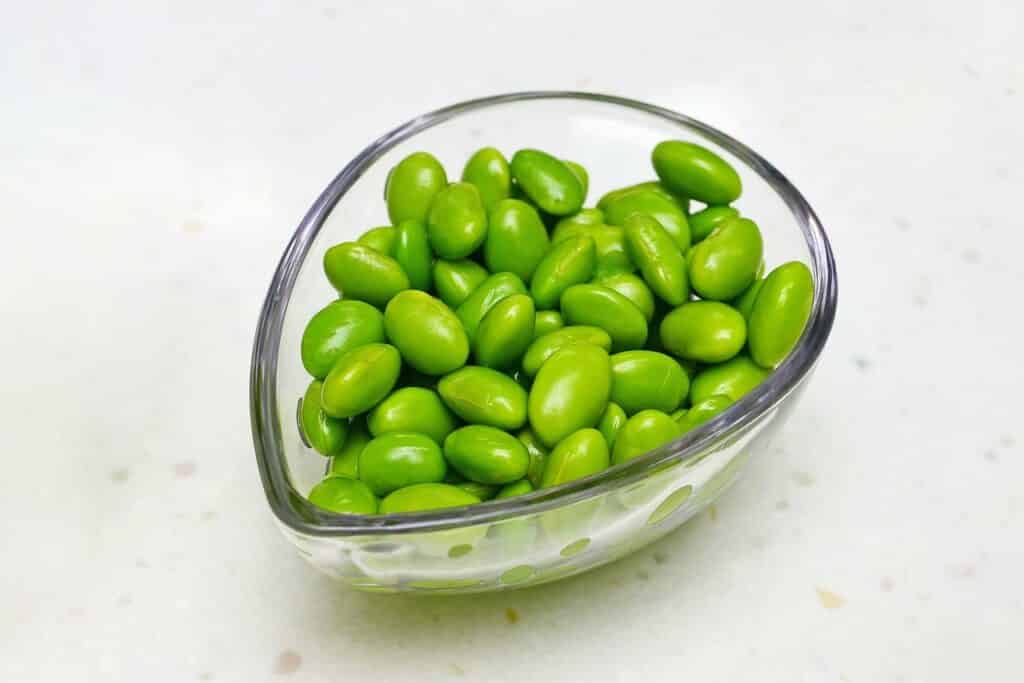You probably love edamame if you’re like me, and you’re always looking for new snacks that are both delicious and nutritious.
Kudos!
but wait; before you go throwing a handful of edamame in your mouth, you might want to think about sharing it with your furry friend.
After all, what’s good for you is often good for them, or maybe not?
So, can dogs eat edamame?
Yes, but in moderation.
Edamame is a nutritious vegetable that contains protein, vitamins, fats, and minerals.
Your dog will benefit from these nutrients.
However, it also contains soy, which can be toxic to dogs in large quantities or present an allergy to some.
While preparing edamame for your dog, cook thoroughly to ensure that your pup manages its effective digestion.
This article will explore the effects of edamame on your dog.
We also discuss the nutritional value of edamame for your dog and provide some tips on incorporating it into their diet.
Read on to learn more.

Benefits your dog gets from eating edamame
Edamame is simply soybeans that are still immature, harvested with their pods and shells.
It offers many nutrients beneficial for your pup.
These nutrients are:
- Proteins
- Carbohydrates
- Fiber
- Minerals-manganese and iron
- Vitamins-Vit B9 (folate), Vit K
- Healthy fats-omega 3 and 6 fatty acids
These nutrients will benefit your dog in the following ways:
Building their tissues: Proteins are the main building blocks of your dog’s tissues, including muscles, organs, and skin. Giving your pup edamame will help them maintain healthy tissues as they reap the benefits of the proteins offered.
Providing energy: Carbohydrates are essential for providing your dog with energy. Edamame contains complex carbohydrates that will give your pup sustained energy throughout the day.
Aiding in digestion: Fiber is essential for regulating your dog’s digestive system and keeping them regular. Edamame contains both soluble and insoluble fibers, which can help with diarrhea and constipation.
Maintaining healthy bones: Minerals are essential for keeping bones healthy and preventing disease. Edamame is a good source of manganese and iron, two minerals necessary for keeping your pup’s bones healthy.
Preventing birth defects: Folate is a water-soluble vitamin that helps prevent congenital disabilities. It’s important for pregnant dogs and puppies as it helps develop their nervous system.
Reducing inflammation: Omega-three fatty acids are anti-inflammatory agents that can help reduce swelling and pain in your dog’s joints. They can also improve your dog’s coat and skin health.
Strengthening their immune system: Vitamin K is essential for helping your dog’s blood clot and maintaining a strong immune system.
Weight management: Edamame is a low-calorie food high in protein and fiber. This makes it an excellent option for dogs trying to lose or maintain their weight.
Tips for feeding your dog edamame
Here are some tips on how to incorporate edamame into your dog’s diet:
- Start with a small amount: Edamame contains soy, which can be toxic to dogs in large quantities. It’s important to start with a small amount and see how your dog reacts before giving them more.
- Cook thoroughly: If you choose to prepare edamame for your dog, cook it thoroughly. This will help them digest it more easily.
- Remove the shells and pods: Edamame comes in shells and pods. Remove these before serving your dog to avoid choking hazards.
- Give as a treat: Edamame makes a great treat for your dog. Give them whole or mix it into their food. Provide sparingly and remember the treat’s rule of thumb – no more than ten percent of their daily caloric intake. Ninety percent of their food should come from complete, balanced diets.
Are there any risks to feeding my dog edamame?
Edamame is safe for your dog if they don’t have a soy allergy.
However, it is vital to know that some risks may present with giving your pup this food.
These are:
Gastrointestinal upsets
If your dog consumes too much edamame, they may experience vomiting and diarrhea.
If this occurs, stop feeding them edamame and consult your veterinarian.
Edamame is also high in fiber; hence, too much may cause constipation, bloating, and gas.
Soy toxicity
Edamame contains phytoestrogens, which are plant-based estrogens that may cause reproductive issues.
It’s important to feed your dog edamame as you monitor their reaction to it.
If you notice changes in behavior or health, stop feeding them this food and consult your veterinarian.
Digestion problems
If your dog is not used to eating soy, they may experience indigestion when they consume edamame.
The beans can be challenging for some dogs to digest effectively.
The indigested compounds will remain in the dog’s intestine, causing a blockage.
This will lead to health complications and require expensive surgeries to correct.
Allergic reactions
Some dogs may be allergic to soy.
If your dog has never eaten soy before, it’s important to introduce it slowly and watch for any adverse reactions.
Signs of an allergy include itching, redness, swelling, hives, vomiting, and diarrhea.
If you notice these symptoms, stop feeding your dog edamame and consult your veterinarian.
How should I prepare and serve my dog edamame?
You can give your dog edamame cooked or raw.
Cooking is recommended to make it more tasty and palatable.
It also eliminates the risk of your dog eating parasites which can make them sick, and ensures easy digestion for your dog.
You may prefer to cook for your dog edamame with their pods and shells.
If you choose to do this, ensure to cook thoroughly to make it soft and easily digestible.
It’s, however, recommended to remove the pods and shells before preparing and serving your dog.
You can cook this nutritious food by boiling it in water, microwaving, or steaming.
Cook and allow to cool before serving your pup.
Do not add salts, spices (seasonings), or harmful ingredients to dogs, such as onions and garlic.
To make the dish tastier and appealing for your dog, you can add cottage cheese, chicken broth, or peanut gel.
You may also add other veggies like broccoli, carrots, or sweet potatoes.
Serve your dog edamame as a whole bean or in small pieces.
Mix it thoroughly before serving if you’re adding to their food.
You can serve it with soup, salad, stew, or carbs like rice dishes and oats.
Opt for plain fresh homemade edamame.
Avoid processed ones as these may contain added ingredients that can be harmful to your dog, such as sea salts, fats, soy sauce (with added sodium), and spices.
How much edamame should I give my dog?
Start with a small amount if you decide to feed your dog edamame.
Edamame is a new food for them, and you want to monitor their reaction to it.
If they have never eaten soy before, start with a quarter cup of edamame per day and increase the amount gradually over time if there are no adverse reactions.
In case your dog experiences digestive upsets, discontinue feeding them this food and consult your veterinarian.
Conclusion
Edamame is a healthy, low-calorie food that can offer many benefits for your dog.
Start with a small amount and cook it thoroughly before feeding your pup.
Remove the shells and pods before serving.
You can provide edamame to your dog whole or mix it into their food.
Watch them closely for any allergic reactions and enjoy the benefits that this healthy treat can offer your furry friend.
Contact your veterinarian if you require further advice on edamame or other foods safe for your pup.
They will help you ensure that your dog gets the best they need.
- What Dog Breeds Have Pink Skin? - March 24, 2023
- What Are the Most Inspiring Dog Breeding Quotes? - March 20, 2023
- Can Pheromone Spray Help Improve Dog Breeding Results? - March 19, 2023








